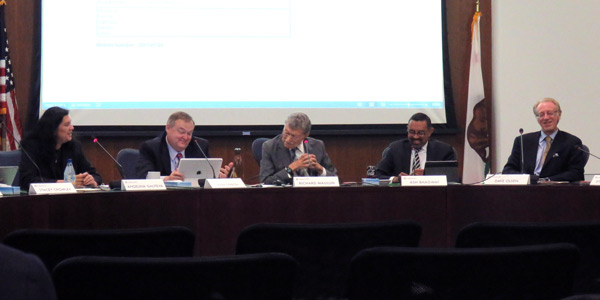By Jason Fordney
FOLSOM, Calif. — The CAISO Board of Governors last week greenlit new rules that allow the grid operator to constrain the operations of gas plants across the state and the Western Energy Imbalance Market (EIM), part of a package of initiatives drawn up in response to the loss of the Aliso Canyon storage facility.
The board unanimously approved the new market rules in a 5-0 vote, as the broader public discussion over Aliso Canyon intensified.

CAISO Director of Infrastructure, Policy Greg Cook | © RTO Insider
CAISO Director of Market and Infrastructure Policy Greg Cook explained to the board that there are still operational risks around the loss of Aliso Canyon. The gas constraint tool is limited to use for physical constraints on the grid, not to manage economic conditions.
“There is potential for similar types of physical gas constraints elsewhere outside of Southern California, and our operators have found that this is a valuable tool” to maintain electric and gas system reliability, Cook said.
CAISO asked the board to approve extending some temporary provisions and make others permanent as it develops a new long-term suite of market rules in its Commitment Cost and Default Energy Bid Enhancements (CCDEBE) proceeding, expected to be implemented in fall 2018.
The EIM Governing Body previously approved elements of the Aliso Canyon Gas-Electric Coordination Phase 3 proposal. (See EIM Leaders Endorse CAISO Gas Constraint Measure.) CAISO will submit the rules to FERC for approval.
The board’s approval extended a temporary rule that the day-ahead market gas price index use information published every morning to better reflect gas costs, and requires a scalar to be included for the next-day gas index to account for tight gas conditions in Southern California and higher gas costs.

CAISO Board of Governors | © RTO Insider
Cook said he hasn’t seen much need for gas constraints in Southern California in the past year, but the ability to use the scalar would be there if unforeseen events happen.
Also approved was a right for gas generators to file for after-the-fact cost recovery of energy costs if units are mitigated down to their default energy bid.
Stakeholders generally support the gas constraint tool but do not want it to replace or affect the package of bidding rule changes being developed in the CCDEBE proceeding. Representatives from NRG Energy and Pacific Gas and Electric said there are concerns about the package but were generally supportive. But many stakeholders have commented that there are broader problems that must be adequately addressed in the CCDEBE proceeding. The Western Power Trading Forum did not support use of the gas constraint tool unless the scalar is retained.
CAISO’s Department of Market Monitoring had expressed concerns about the Phase 3 proposal, but its concerns have been addressed, including an eventual automation of the process whereby constrained transmission paths are deemed uncompetitive and constraints are implemented.
NRG Director of Regulatory Affairs Brian Theaker told the board that his company originally opposed the Aliso Canyon mitigation procedures because it distracts attention from CCDEBE and “long-standing problems with regards to the ISO bidding structure.” Suppliers cannot reflect gas procurement costs in bids and could not recover those costs, he said.
The company’s opposition has been “tempered a little bit” because of process on CCDEBE, he said. “CCDEBE is a long way off,” and the company supports extending the Aliso Canyon measures.


